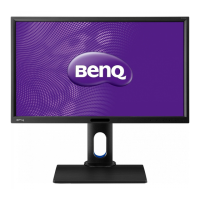
Do you have a question about the BenQ BL2420U and is the answer not in the manual?
| Color | black/non-glossy black, black |
|---|---|
| Tiltable | yes |
| OS Compatibility | windows, mac |
| Screen Size | 24 inches |
| Aspect Ratio | 16:9 |
| Resolution | 3840 x 2160 |
| Native Resolution | 3840 x 2160 |
| Refresh Rate | 60hz |
| Horizontal Viewing Angle | 178 degrees |
| Vertical Viewing Angle | 178 degrees |
| Response Time | 7 milliseconds |
| Brightness | 300 candela per square meter |
| Contrast Ratio | 20, 000, 000:1 |
| Horizontal Scan Rate | 140 kilohertz |
| Power Consumption | 58 watts |
| Depth with Stand | 9.4 inches |
| Width with Stand | 22.2 inches |
| Net Weight without Stand | 15.7 pounds |
Instructions for safe operation and connection of the monitor to prevent electrical hazards.
Instructions for safely cleaning the LCD monitor surface and ensuring proper ventilation.
Advises against self-servicing and recommends contacting qualified personnel for repairs.
Detailed instructions for connecting D-Sub, DVI-D, and HDMI video cables.
Instructions for connecting DisplayPort and audio cables, including troubleshooting.
Guide on connecting USB devices, power cable, and organizing cables.
Optional step for headphone hook and steps to connect power and turn on the monitor.
Instructions for turning on the computer and installing monitor software.
Importance of installing the BenQ LCD Monitor driver software for optimal performance.
Step-by-step guide for installing the monitor driver on a new computer using the CD-ROM.
Instructions for manually updating monitor driver software on Windows computers.
Step-by-step guide for installing the monitor driver on Windows 10 using the CD-ROM.
Step-by-step guide for installing the monitor driver on Windows 8/8.1 using the CD-ROM.
Step-by-step guide for installing the monitor driver on Windows 7 using the CD-ROM.
Information on using Display Pilot software for monitor control and rotation.
Guide on using the Auto Adjustment feature for optimal analog signal display.
Guidance on selecting various picture modes for different image types.
Details the Auto Adjustment feature for optimizing analog (D-Sub) input signals.
How to select input source and adjust geometry (H/V Position, Pixel Clock, Phase).
Guide on selecting various picture modes like sRGB, CAD/CAM, and Animation.
Explanation of the Eye Protect feature that adjusts backlight based on ambient light.
Explanation of the ECO sensor for detecting presence and saving power.
Solutions for blurred images, including resolution, refresh rate, and cable checks.
Troubleshooting steps for pixel errors like dead or stuck pixels.
Steps to fix color issues, including resetting color settings and checking cables.
Solutions for distorted or flickering images, focusing on resolution and display mode.
How to unlock OSD controls if they are locked.
Troubleshooting steps for audio issues, checking connections and volume.